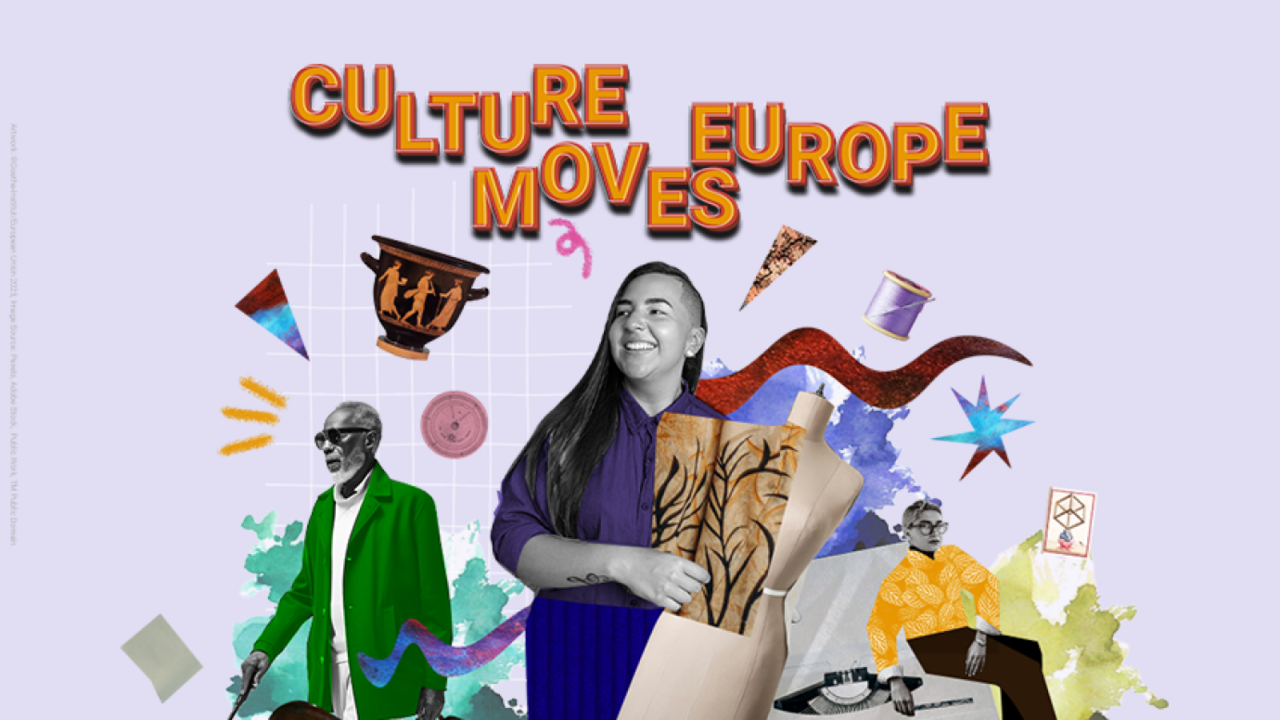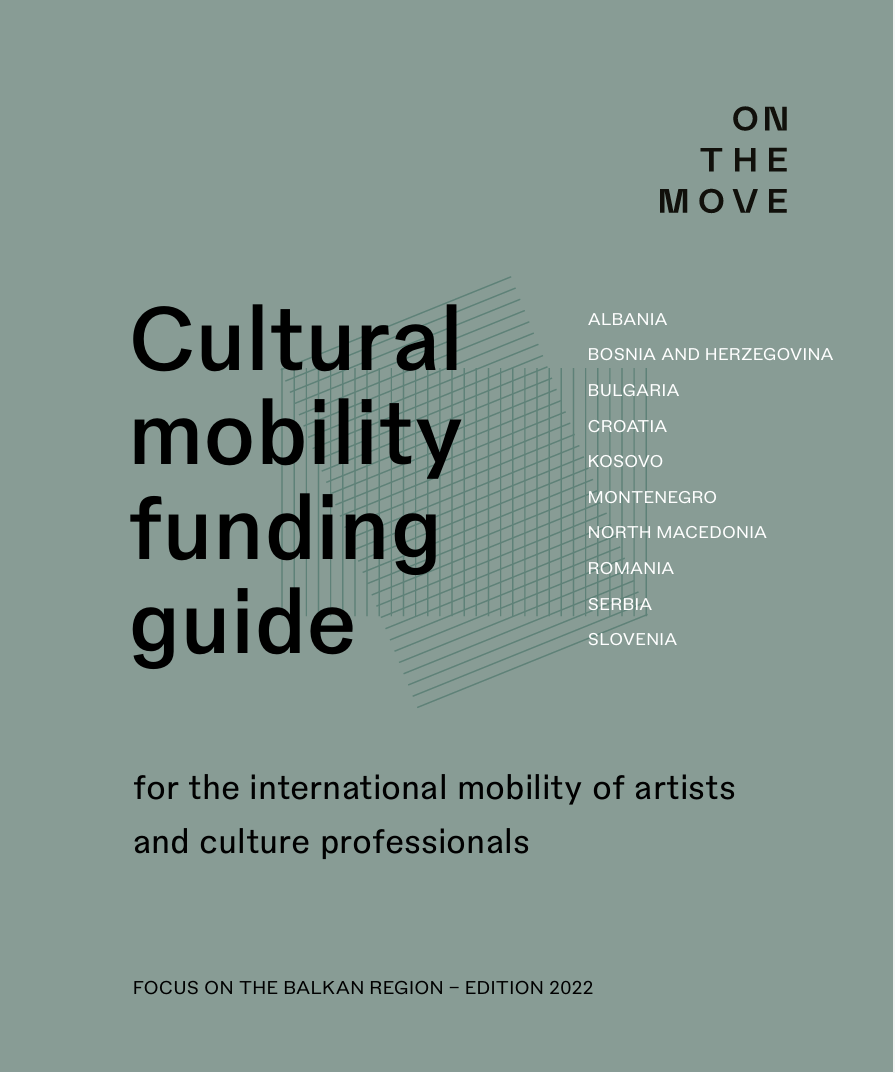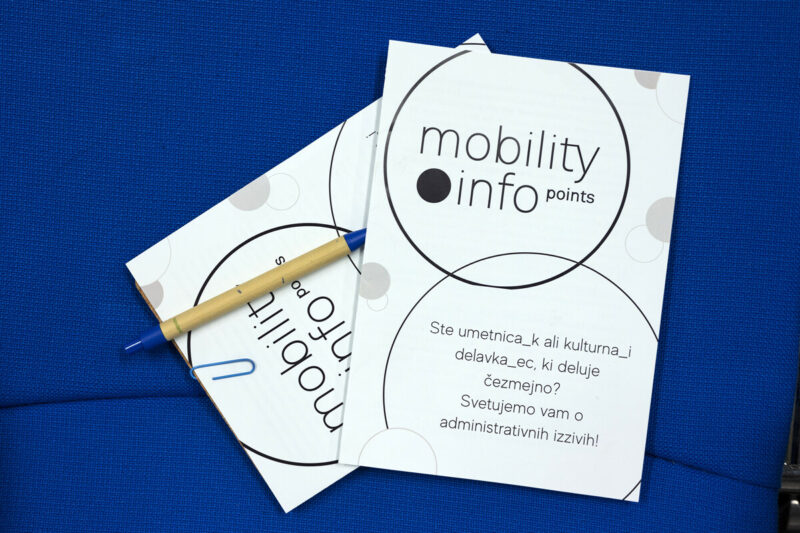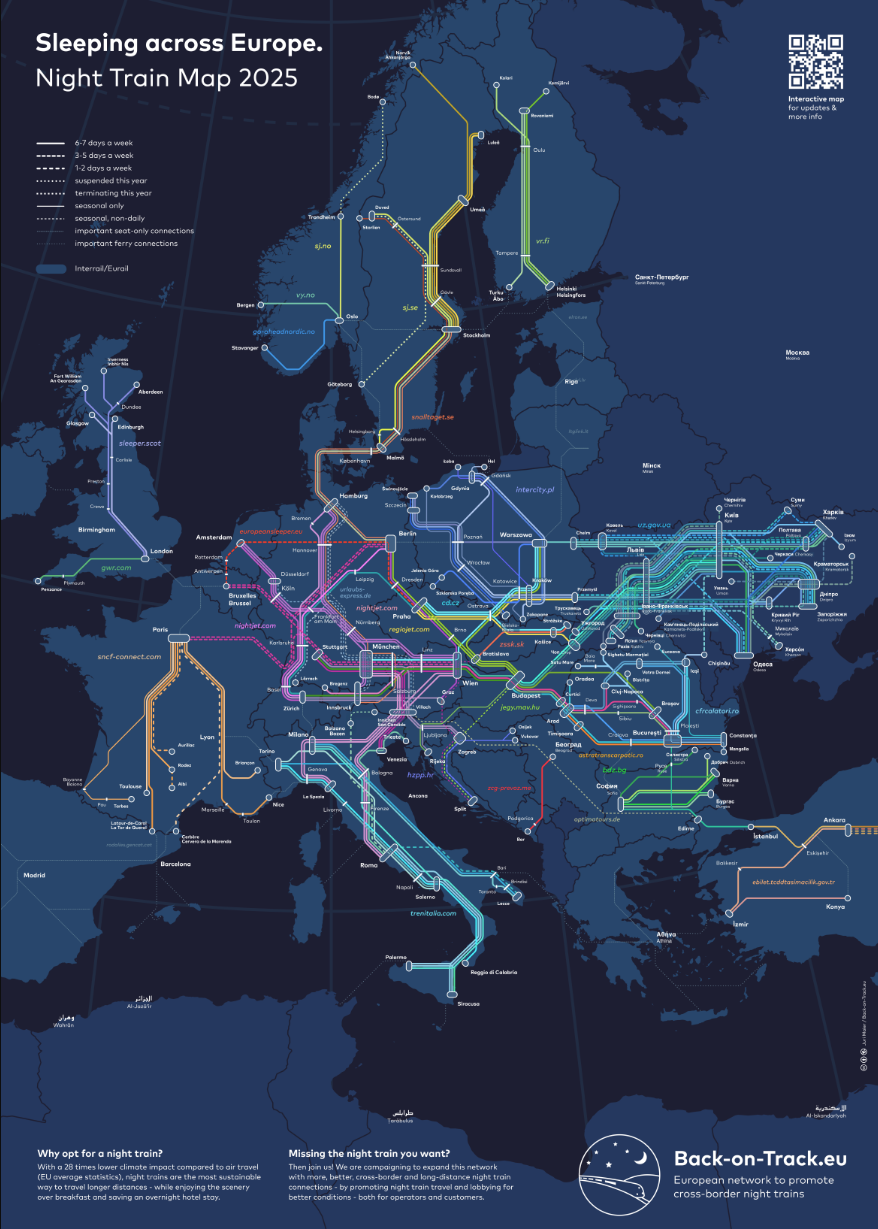Green Pathways to Slovenia
Advice for Sustainable International Mobility of Artists and Cultural Workers
Marie Le Sourd of On the Move, a network that has been encouraging fairer and more sustainable mobility practices in the cultural sectors for years, emphasises that all stakeholders share the responsibility for green mobility – from artists to funders who can provide fairer access to and distribution of resources. Mobility in culture is not just about getting from point A to point B; we must understand it holistically and put reciprocity, balanced exchange, openness, erasure of inequality and longevity in the forefront.
 Marie Le Sourd at the On the Move network assembly, 2025.
Marie Le Sourd at the On the Move network assembly, 2025.
Green mobility involves more than a question of the modes of transportation; it is also a question of why and how we travel, what we do and how long we stay, what we leave behind and what we take with us. It thus includes different contexts in which artists and cultural workers operate, their reasons for mobility, how they interact or connect with the new environment and the effects of their activities on the destination during their stay and after their return.
Slovenia, located in the centre of Europe and with a cultural sector that has strong international connections, is an attractive destination for visiting and resident artists who are increasingly looking for green events, residencies and hosts. If you work in the CCS and are planning to visit Slovenia, this article can serve as a practical map of green pathways that lead you into the Slovenian cultural landscape.
Securing Funding for Green Mobility
A significant portion of green mobility occurs before anyone ever packs their bags. Frequently, planning mobility, creating an art project and securing funding go hand in hand. Many artists and cultural workers have to rely on financial support, and fortunately, in Europe, some opportunities encourage green mobility by rewarding artists’ environmentally friendly choices.
Culture Moves Europe
The most important – and currently the only – scheme that systematically supports mobility in culture on the European level is Culture Moves Europe. Funded by the European Union as a part of the Creative Europe programme, it was implemented by the Goethe-Institut in Brussels between 2022 and 2025. The support is intended for individuals and groups of up to five people for individual mobility, as well as organisations and individuals who host residencies. Eligible applicants are those from all 40 member countries of the Creative Europe programme, working in the fields of architecture, cultural heritage, design and fashion, books, music, performing arts and visual arts. With a total budget of 21 million EUR, between October 2022 and June 2025, around 7,000 grants were given. The new generation of the programme begins in the autumn of 2025.
Given the value of this opportunity, it is sensible to develop one’s project concept thoroughly. In the previous call, the art projects had to cover two of the four goals: research of the artistic topic or concept, creating new work, improving competencies and skills, and the development of professional networks or audiences. The project must be carried out in collaboration with a selected partner in a different Creative Europe country. However, this partner does not need to be an organisation; for example, a host can be another artist. The past call did not support mobility with the intent to present already created artworks.
The amount of support is determined individually, depending on the project and the applicant’s personal circumstances. The scheme provides different top-ups to encourage green mobility. Here, green mobility is considered not only from the aspect of decreasing the carbon footprint but also in the sense of greater fairness and accessibility. The green top-up is thus available to those who do not board a plane to cover a distance longer than 600 km. A family top-up is available for residency programme participants who have children under 10 years of age, while accessibility support is available to persons with disabilities. There are also top-ups provided for travel from or to the most remote areas and for expenses related to obtaining a visa.
 Culture Moves Europe, Call for Individual Mobility 2025, banner.
Culture Moves Europe, Call for Individual Mobility 2025, banner.
Guides of the On the Move Network
When looking for opportunities for mobility, visit the On the Move network website, which connects 86 members from all around the world. Together with network partners, they have prepared more than 60 national and regional guides for artists and cultural workers seeking support for their cross-border mobility into a particular country. The guides include more than 2,000 grants, subsidies, residencies and other programmes.
The guide for Southeastern Europe was published in September 2022, and it brings an overview of funding programmes that support the mobility of artists and cultural workers from or to the region’s ten countries: Albania, Bosnia-Herzegovina, Bulgaria, Croatia, Kosovo, Montenegro, North Macedonia, Romania, Serbia and Slovenia.
It also includes opportunities provided by public and private funders in all fields of the arts, from international organisations and national institutions to local bodies and foundations. The listed funding schemes have regular application cycles, with online information and open calls. The guide does not include one-off or temporary opportunities or those that are by invitation only. The presented programmes support different forms of mobility (residencies, workshops, grants, training programmes, networking opportunities), and they must cover at least part of the travel costs. In accordance with the principles of green mobility, those programmes that offer additional funding for travelling overland, for persons with disabilities or their carers and for digital or hybrid forms of cross-country collaboration are specifically highlighted.
 On the Move, "Cultural Mobility Funding Guide – Focus on the Balkan Region", September 2022.
On the Move, "Cultural Mobility Funding Guide – Focus on the Balkan Region", September 2022.
Other Green Opportunities
Guest artists and artists-in-residence can also look for support among the ad hoc opportunities that Slovenian organisations offer as a part of their European or national projects. Because they appear while the individual projects are ongoing and not as a part of permanent, regular cycles, we will most likely not find these opportunities listed in the On the Move network’s guide for mobility funding. You can discover calls for residencies, guest appearances and collaboration by establishing contacts with relevant organisations or by checking their websites regularly.
Many of these projects are supported as part of the Creative Europe programme, which requires applicants to respect sustainability principles and green practices in all their activities, including artist mobility. Two such examples are the European cooperation projects OASis – Open Art Spaces in Synergy, carried out by KIBLA, and Projekt Atol Institute’s The Data and the Sovereign. Both projects have residency calls or opportunities.
 Project Atol Institute’s open residency call within the "The Data and the Sovereign" project. Design by Márk Fridvalszki, 2025.
Project Atol Institute’s open residency call within the "The Data and the Sovereign" project. Design by Márk Fridvalszki, 2025.
Other initiatives can be funded on the national level – in the frame of its Public Call for the Green Transition in Culture, six Slovenian organisations received funding from the Climate Change Fund to carry out their international festivals and other events. Among the recipients were, for example, the Slovene Writers’ Association for the green transition of the Vilenica international literary festival and Otok Institute with its international film festival Kino Otok – Isola Cinema. The green-oriented residency calls, festivals and events are invaluable, although they are not regular opportunities to get mobility support that aligns with sustainable goals.
Mobility Information Point
If you need information, advice or assistance in solving administrative challenges connected to international mobility and cross-border work, you can turn to the Mobility Information Points (MIPs). These central contact points for individuals and organisations working in art and culture provide support by offering free information and guidance on key questions, such as residency and work permits, social security, taxes and customs. However, they cannot provide you with letters of invitation or influence governments and embassies.
Currently, there are eleven operational mobility information points: in the UK, in the USA, Austria, Belgium, France, Germany, Czechia, the Netherlands, Portugal, Sweden and Slovenia, where the tasks and activities of MIP are performed by Motovila, which cooperates with other MIPs and is also a member of the On the Move network. Motovila provides not only practical advice regarding green mobility in Slovenia but can also help you find funding and connect with relevant experts and organisations.
 Mobility Information Point in Slovenia is operated by Motovila Institute.
Mobility Information Point in Slovenia is operated by Motovila Institute.
Sustainable travel to Slovenia
For your trip to Slovenia to be as sustainable as possible, choose train travel over travelling by plane or car. Sebastian Hoffman of the German mobility information point (MIP DE – touring artists), which operates under the auspices of the Internationales Theaterinstitut (ITI), provided some useful tips for travelling across Europe by train.
1. Research reliable sources to purchase tickets. When planning your journey, do not rely on your national railway operator or on larger online ticketing platforms. Hoffman suggests you visit the website The Man in Seat 61, which provides carefully researched, up-to-date information about travelling by train in almost all the countries in the world – including connections to Ljubljana. Hoffman also recommends visiting the website of the German operator Deutsche Bahn, as it has the most extensive database in Europe. Although this platform will not sell you (most) tickets, it is handy for planning your journey.
2. Compare the prices of different railway providers. Hoffman warns that the prices of tickets for direct international trains can differ significantly depending on which railway operator you buy them from. If you travel to Slovenia with a direct train from a neighbouring country, compare the prices on different national operators’ websites. The journey on a direct train from Vienna to Maribor is cheaper, for example, when booked via the Austrian operator, instead of the Slovenian one. But it often happens that the ticket is cheaper when you book it via a foreign operating system – even when you don’t live in that country.
3. Consider an Interrail ticket for longer journeys. If you plan a longer trip with several stops, Hoffman recommends you consider purchasing an Interrail ticket. Using Global Pass, you can travel to or from Slovenia through several countries over a longer period of time. These passes are often on sale and can be activated even several months after buying. But be careful – you will need to pay a reservation fee in addition to the ticket if you want to travel on fast trains (e.g., the Italian Frecciarossa). As the seats on these trains often sell out weeks in advance, it is important to plan your journey early enough. You can also consider an Interrail ticket if you want to use trains to explore the country once you arrive in Slovenia; the Slovenia Pass is available for 3, 4, 5, 6 or 8 days.
4. Plan your stopovers smartly when travelling internationally. If your journey to Slovenia has stopovers, you will likely need to purchase several tickets from different national railway carriers. Hoffman advises checking in advance if these carriers are a part of the Railteam alliance; if they aren’t – as is the case with Slovenian Railways – you will not be able to simply hop on the next train free of charge if your train is delayed or cancelled. So plan your travel with some extra time built in or even with an extra overnight stop.
Longer stopovers, for example, in Trieste, Zagreb or Vienna, can become an opportunity to explore or meet local artists and organisations. Clever stopover planning doesn’t just optimise your journey, it also aligns with the principles of slow mobility, which is more sustainable and based on a smaller number of trips, slow travel and longer stays.
5. Explore the night train options. If you’re coming to Slovenia from afar, check what the options are for travelling on night trains. Hoffman suggests using the map by the NGO Back on Track, which regularly updates the overview of international night connections. Ljubljana is a stopover for the night trains Zagreb–Zürich, Zürich–Zagreb, Stuttgart–Zagreb, Zagreb–Stuttgart, Budapest–Rijeka, Rijeka–Budapest, or you can use the night train to arrive in a different large city nearby.
 Night Train Map by the NGO Back on Track, 2025.
Night Train Map by the NGO Back on Track, 2025.
6. Follow the news from the railroad world. Because railway connections, regulations and offers change all the time, it is advisable to follow the social media profiles of relevant experts, organisations and platforms, such as The Man in Seat 61, Jon Worth, Back on Track, Europe by Rail and European Rail Timetable.
Green Steps Around Slovenia
Your journey doesn’t end once the train or another sustainable means of transportation brings you to Slovenia. From borrowing bicycles to renting electric cars, the country offers several environmentally friendly travel options.
For shorter distances, biking is a good choice; BicikeLJ is Ljubljana’s public bike-sharing network, very popular with the locals, and following the capital’s example, other municipalities offer bike rental, too. You can travel around Slovenia using modern electric trains, while the Park & Ride system helps reduce traffic congestion in the cities and emissions. Avant2Go provides electric cars for rental to travel short distances, and charging stations for e-cars are available throughout the county. For more tips on how to travel around Slovenia sustainably and relevant links, take a look at Sustainable mobility in Slovenia – let’s go green together on the Slovenian Tourist Board website.
Green Cultural Practices in Slovenia
Artists who champion green mobility will find a well-developed ecosystem of sustainably oriented cultural organisations and initiatives. An increasing number of cultural institutions incorporate sustainability into their daily operations and internal organisation, as well as into their activities, which you can join as a guest or resident artist.
In related articles on Culture.si, you can read more about the Slovenian green cultural scene. We point out some of the most sustainability-oriented residency programmes, such as the Goga Literary Residency of the Goga Publishing House, programmes in the International Centre of Graphic Arts’ Švicarija Art Centre, Krušče Creative Center and Mekinje Monastery, and green international festivals and events such as Vilenica, Kino Otok – Isola Cinema, Mladi levi Festival, PIFcamp and CONA Institute’s TO)pot festival. We will also introduce the projects by organisations that actively encourage sustainable practices. Follow Culture.si for more information about the diverse Slovenian cultural landscape!
Author bio
Nika Mušič has a background in comparative literature and many years of experience in publishing, where she worked as an editor in the field of contemporary and children’s literature, as well as a proofreader and literary critic. Since 2024, she has been employed at Motovila (CED Slovenia), fostering cooperation in the cultural and creative sectors.
The text was written in June 2025 in the framework of the public procurement "Development and upgrade of information portals of the Ministry of Culture for the transition to the eKultura platform" in which Motovila Institute collaborates as a partner with Ljudmila Art and Science Laboratory.
See also
- Greening Practices in Culture: Slovenian Organisations in Action
- Greening Practices in Culture: Artist-in-Residence (AiR) Programmes in Slovenia
- Creative Europe Desk Slovenia
- Motovila Institute
- Slovenian Tourist Board
External links
Green mobility
- On the Move website
- Green Mobility is a Shared and Collective Responsibility: Interview with On the Move Secretary General Marie Le Sourd on the On the Move website
- Cultural Mobility Funding Guide – Focus on the Balkan region (PDF)
Find funding for green mobility
Explore green travel options
- Sebastian Hoffmann: Six tips on how to travel by train in Europe on the On the Move website
- The Man in Seat 61 website
- Deutsche Bahn website
- Interrail website
- Slovenian Railways website
- Railteam website
- Back on Track website
- Night Train Map 2025 on the Back on Track website
- Sustainable mobility in Slovenia – let’s go green together on the www.slovenia.info portal

